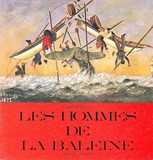Vive la baleine / Mario Ruspoli

1972 – France – [30′ reduced to ?] 18′ – 35 mm – Color
After Mario Ruspoli’s Les hommes de la baleine (1956), with commentary written by Chris Marker, the two men decided to work together on a new film about cetacean fishing: Vive la baleine.
This time, however, there was no question of showing traditional sperm whaling. It’s purely and simply about denouncing an unacceptable massacre, that of the blue whales, the largest animal that has ever existed.As the 2004 La Rochelle Film Festival aptly summed it up, “for a part of humanity, the whale initially represented an essential means of survival. Then came industrialization, and with it big business. Whaling became a means of making a profit. The slaughter could begin. That’s the story told in this no-nonsense documentary.” Although today a moratorium prohibits whaling, and despite the fact that Japan, Iceland and Norway continue their exactions under scientific pretexts, the figures are there.
Indeed, the International Whaling Commission (IWC), founded in 1948, had set up a whaling management system that proved to be a total failure. “The conversion system known as the Blue Whale Unit (BWU), which establishes equivalence between the different baleen whale species according to the average quantity of oil that can be extracted from them (1 blue whale = 2 fin whales = 2.5 humpback whales = 6 Rudolph’s whales), as well as the establishment of a global quota for all whaling nations, led to the massacre of the largest whales and brought their populations to the brink of extinction. It wasn’t until the 1960s that country quotas were adopted, and in 1972 the Blue Whale Unit was abolished.“
Mario Ruspoli, always passionately involved in his projects, didn’t stop there. In addition to his film, he published a second book on the subject entitled Whale Men (1972), in reference to his first film of the same name (1956), which had been released shortly after his book In Search of the Sperm Whale (1955).
In this second opus, Ruspoli takes stock of the hunt, following the Stockholm Conference in June 1972, which called for a ten-year halt to whaling to allow cetaceans to renew themselves. He tells us, among other things, that in 1964, the peak of the massacre, 357 gunboats and 23 floating factories killed 33,001 cetaceans, including 372 blue whales, and that of the 150,000 blue whales alive in 1930, less than 1,000 remained in 1966, a massacre mainly due to the Norwegians.
In 2007, Icarus published a heavily revised English version, as Lynne Sachs, who worked actively on the translation with Chris Marker, tells us.
“Three years ago, Jon Miller, president of our mutual distributor Icarus Films, contacted me to see if I would be willing to assist Chris in the making of a new English version of his 1972 film Vive la Baleine, a passionate, collage-based essay film on the plight of the whales. Of course, I was honored and immediately said yes. For one whole year, Chris and I corresponded weekly as we re-wrote and updated the narration and I searched for a male and a female voice-over actor to read the two parts. He renamed the new 2007 version of his film Three cheers for the whale. It is distributed with other “bestiary” films he has made including The case of the grinning cat.
Be that as it may, Three Cheers for the Whale is an exemplary documentary in its didactic approach, as well as being a scathing pamphlet against the mercantilism of the fishing industry. It’s also worth noting the scarcity of documents concerning this film, about which little or nothing is known. In 2016, Argos Films and Éditions Montparnasse released a remarkable boxed set of Mario Ruspoli’s films, including Vive la baleine and Les hommes de la baleine, with an extensive, well-detailed booklet.
Finally, in the “Nota filmografica” inserted at the end of the volume (pp. 193-196) of Scene della terza guerra mondiale 1967-1977, the Italian version of Fonds de l’air est rouge, published in 1980, mention is made of a film entitled Vive la banlieue (Long Live the Suburbs), co-directed by Marker and Mario Maret in 1972. There’s no doubt that it’s actually Mario Ruspoli’s Vive la baleine.

Livre – 1972 – 148 p.

Coffret dvd – 2007

Coffret dvd – 2011
Générique (début, dans l’ordre d’apparition, complété par le site du Festival de La Rochelle)
Argos Films – 1972
Vive la baleine
baleines: Mario Ruspoli
vivats: Chris Marker
assistés par: Germaine et Mario Chiaselotti
[voix off:]
voix magistrale: [Louis] Casamayor
voix intérieure: Valérie Mayoux
voix musicale: Lalan [van Thienen]
générique: Timour Lam
[montage, son_et commentaire: Chris Marker]
[image: Michel Boschet]
[production: Argos Films]
Version anglaise (2007):
(sous titrage du générique début)
Three cheers for the whale
whales: Mario Ruspoli
cheers: Chris Marker
master voice: Leonard Lopate
interior voice: Emily Hoffman
(ajout générique de fin en anglais)
English version supervisor: Lynne Sachs
English sound mix: Bill Seery
original title drawings: Timour Lam
English titles: Kelly Spivey
English translation: Liza Oberman
A first run Icarus release
